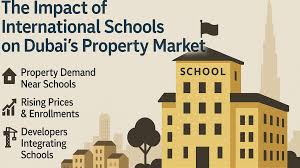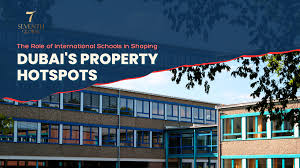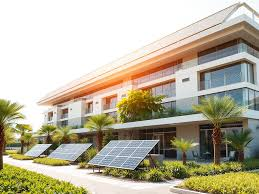Now Reading: Impact of International Schools on Dubai Property Values in 2025
-
01
Impact of International Schools on Dubai Property Values in 2025
Impact of International Schools on Dubai Property Values in 2025

Table of Contents
The presence of international schools in Dubai significantly influences property values in 2025, driven by the emirate’s large expatriate population (88% of residents), growing demand for quality education, and alignment with investor-friendly policies like the Golden Visa Program. As families prioritize proximity to top-tier schools, areas near international schools see increased demand for residential properties, boosting both property prices and rental yields. This analysis explores the impact of international schools on Dubai’s property values in 2025, integrating insights from luxury real estate trends, rental market dynamics, taxation frameworks, and sustainable living trends previously discussed.
Key Factors Driving the Impact of International Schools on Property Values

- Expatriate-Driven Demand:
- Demographics: With 88% of Dubai’s population being expatriates, international schools catering to diverse curricula (e.g., IB, British, American) are critical for families. The Knowledge and Human Development Authority (KHDA) reported 217 private schools in Dubai in 2024, serving over 365,000 students, with 90% of private schools offering international curricula.
- Family-Oriented Buyers: Expatriate families, including professionals and high-net-worth individuals (HNWIs) drawn by the Golden Visa (AED 2 million property investment threshold), prioritize properties near top schools, driving demand in specific areas.
- Premium on Proximity:
- Price Impact: Properties within a 3–5 km radius of top international schools command a 15–25% price premium compared to similar properties in non-school zones. For example, villas in Dubai Hills Estate near GEMS Wellington Academy saw a 20% price increase in 2024, with 2025 projections estimating 5–10% growth, aligning with luxury market trends.
- Rental Yields: Areas near schools like Dubai International Academy in Emirates Hills or Nord Anglia International School in Al Barsha offer rental yields of 6–9%, driven by demand for family-friendly rentals, as noted in the rental market dynamics overview.
- Top International Schools and Key Areas:
- Prime Locations: Areas like Dubai Hills Estate, Emirates Hills, Jumeirah Village Circle (JVC), The Springs, The Meadows, and Arabian Ranches are hotspots due to proximity to top schools such as:
- GEMS World Academy (Al Barsha)
- Dubai British School (The Springs, Jumeirah Park)
- Nord Anglia International School (Al Barsha)
- Repton School Dubai (Nad Al Sheba)
- Kings’ School Dubai (Umm Suqeim)
- Market Impact: For instance, JVC saw a 17–19% rental increase for villas and 9–18% for apartments in 2024, partly due to proximity to schools like Jumeirah International Nurseries. In Arabian Ranches, villas near Jumeirah English Speaking School (JESS) command AED 250,000–350,000 annually in rent.
- Golden Visa and Investor Appeal:
- Investment Threshold: The Golden Visa Program, requiring a minimum AED 2 million property investment, drives demand for family-friendly properties near international schools. Investors target areas like Dubai Hills Estate or The Springs to secure residency while benefiting from high rental yields (6–9%).
- Market Boost: The 110 new Golden Visa-eligible listings in May 2025, as noted in prior discussions, include properties in school-adjacent areas, with villas in Emirates Hills (near Dubai International Academy) seeing strong demand.
- Sustainable and Family-Friendly Developments:
- Green Features: As highlighted in the sustainable living analysis, developments near schools like Dubai Sustainable City (close to Fairgreen International School) integrate green-certified designs, such as solar panels and water recycling, reducing utility costs by 20–30% and appealing to eco-conscious families.
- Amenities: Communities with parks, playgrounds, and green spaces (e.g., Arabian Ranches, Dubai Hills Estate) align with tenant preferences for family-oriented amenities, boosting property values by 10–15%.
- Smart Rental Index Influence:
- Valuation Impact: The Smart Rental Index 2025, discussed previously, incorporates proximity to schools as a key valuation criterion. Properties near top schools receive higher star ratings (e.g., four or five stars), justifying premium rents and supporting 13% long-term and 18% short-term rental growth.
- Transparency: Real-time data via the Dubai REST app helps families verify fair rental rates, enhancing trust in areas like JVC or The Meadows.
Taxation and Financial Considerations
- Corporate Tax for Real Estate Professionals:
- Freelancers and Agencies: As noted in the taxation overview, real estate agents or consultants earning over AED 375,000 annually face a 9% corporate tax and must register by March 31, 2025, to avoid a AED 10,000 penalty. Those serving school-adjacent property markets (e.g., consultancy for Golden Visa buyers) must account for tax liabilities.
- Free Zone Benefits: Agents in Free Zones like DMCC can leverage 0% corporate tax on qualifying income (e.g., international client services), but mainland commissions from school-area sales are taxable.
- VAT Implications:
- Residential Properties: As outlined in the VAT overview, residential sales and leases near schools are VAT-exempt, reducing costs for buyers and tenants. For example, a villa in The Springs near Dubai British School incurs no VAT on purchase or rent.
- Commercial and Services: Real estate services (e.g., brokerage for school-adjacent properties) and commercial leases (e.g., school facilities) are subject to 5% VAT, requiring registration for businesses with supplies above AED 375,000.
- eInvoicing: The proposed eInvoicing system (consultation until February 27, 2025) requires agents to issue digital invoices for taxable services, impacting those facilitating high-value transactions near schools.
- R&D Tax Credits for Green Developments:
- Incentive: The 2025 corporate tax reforms offer 30–50% R&D tax credits (effective 2026) for sustainable technologies, encouraging developers to integrate green features in school-adjacent projects like Dubai Sustainable City.
- Impact: These credits reduce tax liabilities for developers, making eco-friendly properties near schools more financially viable and attractive to families.
Implications for Property Values

- Price and Rental Premiums:
- Sales Prices: Properties near top schools in Dubai Hills Estate or Emirates Hills command 15–25% higher prices than similar properties in non-school zones. For example, a four-bedroom villa in The Meadows near JESS averages AED 5–7 million, compared to AED 4–5 million in areas without school proximity.
- Rental Yields: High demand from expatriate families drives 6–9% yields in school-adjacent areas, with villas in Arabian Ranches fetching AED 250,000–350,000 annually, aligning with luxury market trends.
- Investor Opportunities:
- Golden Visa Synergy: Investors targeting AED 2 million properties for Golden Visa eligibility prioritize school-adjacent areas for stable rental income and capital appreciation (5–10% annually).
- High ROI: Properties near schools sell 15–20% faster due to family demand, offering strong returns, especially in off-plan projects like Emaar South near GEMS Founders School.
- Market Stability:
- Demand Consistency: The steady influx of expatriates (6,700 new HNWIs projected in 2024, per Henley & Partners) ensures sustained demand for school-adjacent properties, mitigating risks of oversupply despite 41,000 new units expected in 2025.
- Economic Support: Dubai’s 6.2% GDP growth forecast and infrastructure investments (e.g., Dubai 2040 Urban Master Plan) enhance school-adjacent areas, supporting property value growth.
- Challenges:
- Supply Constraints: Limited inventory in prime school zones (e.g., Emirates Hills, Palm Jumeirah) drives price increases, potentially pricing out some buyers.
- Tax Compliance: Developers and agents must navigate 5% VAT on services and 9% corporate tax, increasing costs for high-value transactions near schools.
- Traffic and Accessibility: High demand for school-adjacent areas can strain infrastructure, requiring urban planning solutions to maintain appeal.
Key Drivers

- Expatriate Demand: 88% of Dubai’s population are expatriates, driving demand for properties near 217 private schools (365,000+ students, 90% international curricula).
- Price Premiums: Properties within 3–5 km of top schools (e.g., GEMS World Academy, Dubai British School) command 15–25% higher prices.
- Rental Yields: School-adjacent areas like Dubai Hills Estate and Arabian Ranches offer 6–9% yields, with villas fetching AED 250,000–350,000 annually.
- Top School Zones: Dubai Hills Estate (GEMS Wellington), Emirates Hills (Dubai International Academy), JVC, The Springs, Arabian Ranches (JESS).
- Golden Visa Synergy: AED 2 million property investments near schools secure residency, boosting demand.
- Sustainable Features: Green-certified properties (e.g., Dubai Sustainable City near Fairgreen International School) align with family preferences, reducing utility costs by 20–30%.
Taxation and Financial Impacts
- Corporate Tax: Agents/freelancers with income >AED 375,000 face 9% tax; register by March 31, 2025, to avoid AED 10,000 penalty.
- VAT: Residential sales/leases exempt; 5% VAT on services (e.g., brokerage) and commercial leases. eInvoicing proposed for 2025.
- R&D Credits: 30–50% tax credits (effective 2026) for sustainable tech in school-adjacent projects.
- Free Zones: 0% tax on qualifying income (e.g., international services in DMCC), but mainland school-area transactions taxable.
Implications
- Price Growth: 5–10% annual increase in school zones; villas in The Meadows (near JESS) at AED 5–7M vs. AED 4–5M elsewhere.
- Investor Opportunities: High ROI (6–9%), faster sales (15–20%), and Golden Visa appeal in areas like Emirates Hills.
- Smart Rental Index: School proximity boosts star ratings, justifying premium rents in JVC, Dubai Marina.
- Challenges: Limited inventory, tax compliance costs, and infrastructure strain in high-demand areas.
Recommendations
- Investors: Target off-plan properties near schools (e.g., Emaar South) for Golden Visa eligibility and high yields.
- Buyers/Tenants: Prioritize green-certified properties in school zones for cost savings and lifestyle benefits.
- Agents: Register for VAT (>AED 375,000 supplies) and corporate tax; adopt eInvoicing for compliance.
- Developers: Leverage R&D credits for sustainable features; use Smart Rental Index data for pricing.
- Stay Informed: Monitor DLD (www.dubailand.gov.ae) and KHDA (www.khda.gov.ae) for school and market updates.
Conclusion
International schools significantly boost Dubai’s property values in 2025, with a 15–25% price premium and 6–9% rental yields in areas like Dubai Hills Estate, Emirates Hills, and JVC. Driven by expatriate demand and Golden Visa investments, school-adjacent properties align with sustainable living trends, offering green-certified designs and smart technologies. The Smart Rental Index 2025 supports transparency, while tax incentives (R&D credits, VAT exemptions) and Free Zone benefits enhance financial viability. Challenges include limited inventory and compliance costs (VAT, corporate tax). Stakeholders should target school zones for high ROI, leverage DLD resources , and consult firms like Emaar or Knight Frank for strategic investments.
WATCH MORE: https://www.youtube.com/watch?v=o7SFmwsWQ6s
READ MORE: Sustainable Living in Dubai: Green Building Trends and Tax Incentives in 2025






















